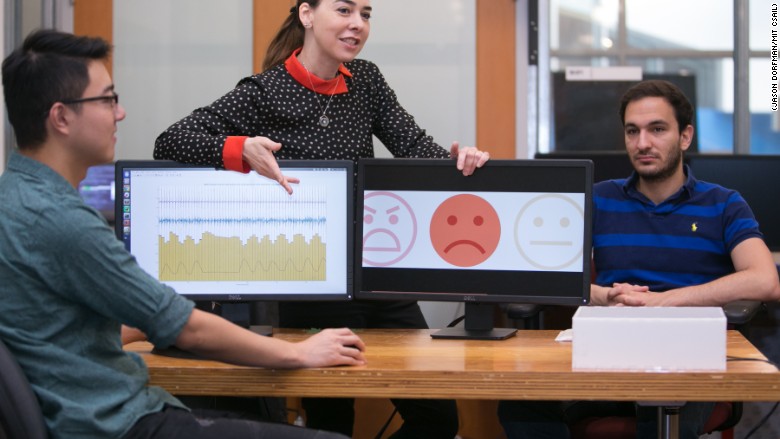
There's a new trick to understanding someone's poker face -- radio waves.
Researchers at the MIT Computer Science and Artificial Intelligence Laboratory have developed a device that uses radio waves to detect whether someone is happy, sad, angry or excited.
The breakthrough makes it easier to accomplish what scientists have tried to do for years with machines: sense human emotions. The researchers believe tracking a person's feelings is a step toward improving their overall emotional well-being.
The technology isn't invasive; it works in the background without a person having to do anything, like wearing a device. The device called EQ-Radio, which was detailed in a paper published online Tuesday, resembles a shoebox, as of now. In the future, it may shrink down and integrate with an existing computing gadget in your home.
It works by bouncing wireless signals off a person. These signals are impacted by motion, such as breathing and heartbeats. When the heart pumps blood, a force is exerted onto our bodies, and the skin vibrates ever so slightly.
After the radio waves are impacted by these vibrations, they return to the device. A computer then analyzes the signals to identify changes in heartbeat and breathing.
The researchers demonstrated their system detects emotions on par with an electrocardiogram (EKG), a common wearable device medical professionals use to monitor the human heart.
Related: Choosing this Instagram filter could mean you're depressed

The machine's analysis of the radio waves relies on artificial intelligence, which learns how various heartbeats indicate certain emotions.
As a part of the testing, the machine bounced radio waves off actors who recreated a range of emotions. The more emotions the machine experienced, the better it identified what signals, such as a fast heartbeat, gave away their true feelings. By monitoring radio waves reflected off people who are happy, the machine is exposed to certain signs -- such as heart rate or a type of breathing -- associated with being in good spirits.
The machine is aware of the number of milliseconds between each heartbeat due to the radio waves. It's these subtle changes in our bodies that give away our emotional state.
MIT professor Dina Katabi, who led the project, believes the work could have significant impact on emotional well-being.
"Imagine if the machines around you can understand when you are stressed or your emotional state is negative," Katabi said. "[It could] try to detect depression."
As Katabi sees it, a device at home could one day email you if it notices you've been sad for awhile. It might suggest you spend more time with friends and family.
There's growing interest among researchers about how machines are qualified to understand our health. Earlier this year, Harvard and University of Vermont researchers found Instagram photos could be analyzed to detect depression. Meanwhile, Microsoft researchers have used web search data to help identify serious illnesses in their development stages.
The MIT device could also be useful for businesses looking to get a better sense of customer emotions. For example, an entertainment company may gauge people's feelings during test screenings of movies and shows.
However, the nature of such a device raises privacy concerns. A device like the EQ-Radio could be placed in a public or private space, and those present may not be aware (or want) information about their emotions is being collected.
In response, Katabi said her team would only use the technology where it had users' consent.
As for now, it's unknown when MIT's device could be used in the real world.

